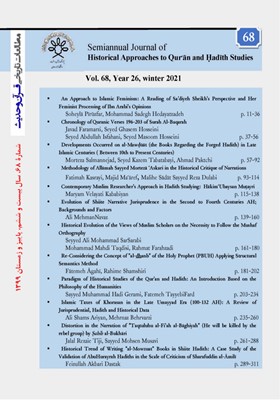-
-
List of Articles
-
Open Access Article
1 - An Approach to Islamic Feminism: A Reading of Sa’diyeh Sheikh's Perspective and Her Feminist Processing of Ibn Arabi's Opinions
Mohammad Sadegh HedayatZadsh Soheyla Piruzfar -
Open Access Article
2 - First Pages
-
Open Access Article
3 - Chronology of Quranic Verses 196-203 of Surah Al-Baqarah
javad faramarzi Qasem Hoseni Abdolla esfahani masoom hosseini -
Open Access Article
4 - Developments Occurred on al-Mawḍūāt (the Books Regarding the Forged Hadith) in Late Islamic Centuries (Between 10th to Present Centuries)
morteza salmannejad Sayed Kazem Tabatabaei pour ahmad pakatchi -
Open Access Article
5 - Methodology of Allāmah Sayyed Mortezā ‘Askari in the Historical Critique of Narrations
fatemeh kasraee Majid maaref Maliha al-Sadat Seyyed Reza Dulabi -
Open Access Article
6 - Contemporary Muslim Researcher's Approach in Hadith Studying: Hākim ‘Ubaysan Muṭayri
maryam velayatikababian -
Open Access Article
7 - Evolution of Shiite Narrative Jurisprudence in the Second to Fourth Centuries AH; Backgrounds and Factors
Ali MehmanNavaz -
Open Access Article
8 - Historical Evolution of the Views of Muslim Scholars on the Necessity to Follow the Mushaf Orthography
Seyed Ali Mohammad Sarsarabi Mohammad Mahdi Taqdisi Rahmat Farahzadi -
Open Access Article
9 - English Abstracts
-
Open Access Article
10 - Re-Considering the Concept of "al-dhanb" of the Holy Prophet (PBUH) Applying Structural Semantics Method
fatemeh agahi Rahimah Shamshiri bebarkateh -
Open Access Article
11 - Paradigm of Historical Studies of the Qur'an and Hadith: An Introduction Based on the Philosophy of the Humanities
SMH Gerami fatemeh tayebifard -
Open Access Article
12 - Islamic Taxes of Khorasan in the Late Umayyad Era (100-132 AH): A Review of Jurisprudential, Hadith and Historical Data
ali shamsariyan mehrnaz behruzi -
Open Access Article
13 - Distortion in the Narration of "Taqtuluhu al-Fi'ah al-Bāghiyah" (He will be killed by the rebel group) by Ṣahih al-Bukhāri
Jalal Rezayi Tiji seyed Mohsen Musavi -
Open Access Article
14 - Historical Trend of Writing "al-Mowzuat" Books in Shiite Hadith: A Case Study of the Validation of AbuHurayrah Hadiths in the Scale of Criticism of Sharafuddin al-Āmilī
Feyzollah Akbari Dastak
-
The rights to this website are owned by the Raimag Press Management System.
Copyright © 2021-2025







